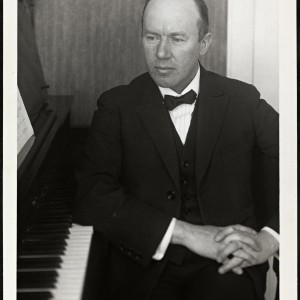
David Monrad Johansen was born in Vefsn in the Nordland region of Norway on 8 November 1888, the fifth of seven children. His childhood was marked by illness in the family. His father died when David was barely six years old and only three of his siblings grew to adulthood. After an unsuccessful new marriage, his mother left and moved with the chidren to Kristiania (Oslo) in 1904. In spite of a difficult family situation, Monrad Johansen described his childhood…
David Monrad Johansen was born in Vefsn in the Nordland region of Norway on 8 November 1888, the fifth of seven children. His childhood was marked by illness in the family. His father died when David was barely six years old and only three of his siblings grew to adulthood. After an unsuccessful new marriage, his mother left and moved with the chidren to Kristiania (Oslo) in 1904. In spite of a difficult family situation, Monrad Johansen described his childhood as happy. However, the break with his chidhood in Helgeland and the encounter with new surroundings in the capital created a longing within him that became an artistic driving force throughout his whole life. He himself thought that an impression of childhood experiences in Vefsn could be traced in his music.
David Morad Johansen had his first piano lessons in Mosjøen at the age of ten. In Kristiania he continued his studies with Per Winge, Christian Johnson amd Karl Nissen. He made his debut as a pianist in Kristiania in 1913 and afterwards was frequently employed as an accompanist. Monrad Johansen received his basic education in music theory from Per Steenberg, Catharinus Elling and Iver Holter. After a year of study at the Music Academy in Berlin (1915-16), he became convinced that the traditional teaching of harmony and the legacy of Edvard Grieg stood in the way of his development as a composer. He continued his studies by himself and steeped himself in the modern books on harmony by A.Eaglefield Hull and Arnold Schönberg. Along with his systematic study of Claude Debussy’s piano works, he found his way to a new stylistic platform.
Throughout the 1920s Monrad Johansen developed a simplified style, characterised by elements of Norwegian folk music and modal harmony. This came out clearly in Draumkvedet (Dream Ballad) for male-voice choir, the song-cycle Nordlands Trompet (Nordland’s Trumpet) and the piano suite that was based on folk music from Gudbrandsdal. His style culminated in the monumental work Voluspå for choir, soloists and orchestra (1926) with a text from the Elder Edda, regarded as Monrad Johansen’s principal work.
Studies with Fartein Valen in Paris in 1928 awoke Monrad Johansen’s interest in atonal counterpoint, but he never completely freed himself from a tonal anchor in his musical language. In 1933, at 45 years of age, he went to Leipzig to study counterpoint with Herman Grabner. With a basis in Neoclassicism and a new understanding of the art of line in music, he now developed a style that characterised the last third of his not very extensive opus list.
At the same time as Monrad Johansen was seeking numerous international impulses to find his own distinctive musical language, he was also considered a flag-bearer for the nationally oriented musical style that was developing in the interwar period. His interest in folk music lay not first and foremost on the melodic level. He regarded folk music and folk literature as vigorous expressions of a genuine, indigenous folk spirit or national character that could be furthered and ennobled through music.
David Monrad Johansen died in Bærum on 20 February 1974 at 85 years of age.
Ivar Roger Hansen, 2016